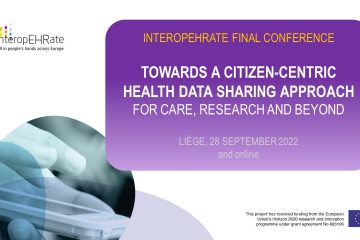InteropEHRate Mid-term Public Workshop attracted a large and diversified audience
In October 2020, InteropEHRate organised a Public Workshop to disseminate the progress made on health data sharing during the first half of the project and receive feedback from 115 experts and key stakeholders.
Two online sessions were organised targeting different audiences. The first session “InteropEHRate Scenarios and Data Flows” was tailored to end-users, ranging from European citizens, health professionals, healthcare organizations and health authorities. The second session “InteropEHRate Architecture, Protocols and APIs” was oriented to the technology industry including health IT managers, national eHealth competence centres, EHR providers, digital health app developers, experts in interoperability from Standards Development Organisations, and related EU-funded projects.
InteropEHRate Scenarios and Data Flows
A keynote from Dr Ceri Thompson (DG CONNECT, European Commission) set the scene describing European policy priorities on health data sharing and the European Health Data Space. The InteropEHRate project coordinator Matteo Melideo (Engineering, Italy) provided an overview of the project and gave the floor to the presentation of the three scenarios: the healthcare visit abroad, the emergency access and the data exchange for research.
In the healthcare visit abroad scenario, Vincent Keunen (Andaman7, Belgium) and Adrian Bradu (SIMAVI, Romania) introduced how to access patient data at the point of care with InteropEHRate solutions. Three live demos illustrated how citizens are equipped with Smart EHR (S-EHR) to manage their health records, how they can connect and retrieve data from healthcare providers and how they can share it cross-border with other healthcare providers with or without internet connections using mobile and desktop apps powered with InteropEHRate open protocols.
Complementing the first scenario, George Petrescu (SCUBA, Romania) presented the second scenario where healthcare professionals can retrieve personal health data from the S-EHR cloud when the patient requires urgent care and is unconscious. Access to health data in emergency situations through this mechanism is verified, secured and fast. Data is encrypted and the cloud provider cannot access patient’s data. Only the patient and the patient’s trusted provider can access the data.
Decentralised data-sharing for research was presented by Stefano Dalmiani (FTGM, Italy). Different types of research studies that can be undertaken if more health data is collected by research centres were described. InteropEHRate protocols enable citizens to control, provide consent and share personal health data with research centres who can therefore contact potentially more people, a big advantage for the secondary use of data.
Closing the showcase, Francesco Torelli (Engineering, Italy) summarised the key features and added value of the citizen-centred InteropEHRate approach as complementary at the European level. In the traditional healthcare-centred approach, data are governed by healthcare providers while in the citizen-centred, data are governed by citizens. The key advantages of InteropEHRate are its open specifications, not tied to a specific vendor, the easiness to move data from different sources to different destinations, the compliance with eIDAS to apply the same credentials, the semantic tools to convert data in different languages, and the exploitation of digital signatures in different protocols. From an end-user point of view, citizens can be more aware of their health and the user of their data, protecting privacy in cloud storage. Researchers benefit from receiving richer and larger data and can enlarge their geographical scope.
Ultimately, the combination of both approaches is synergetic and considers citizens, healthcare organisations and research centres as peers.


